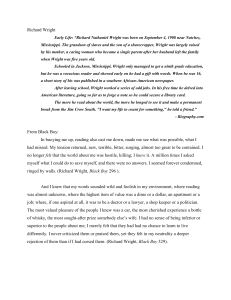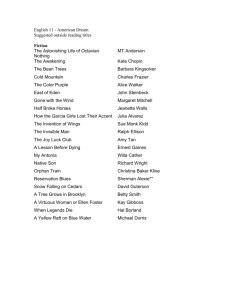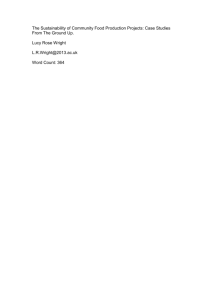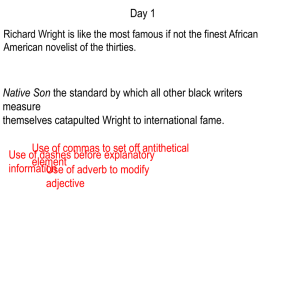Daniela Andronache: The City in Richard Wright's Fiction
advertisement
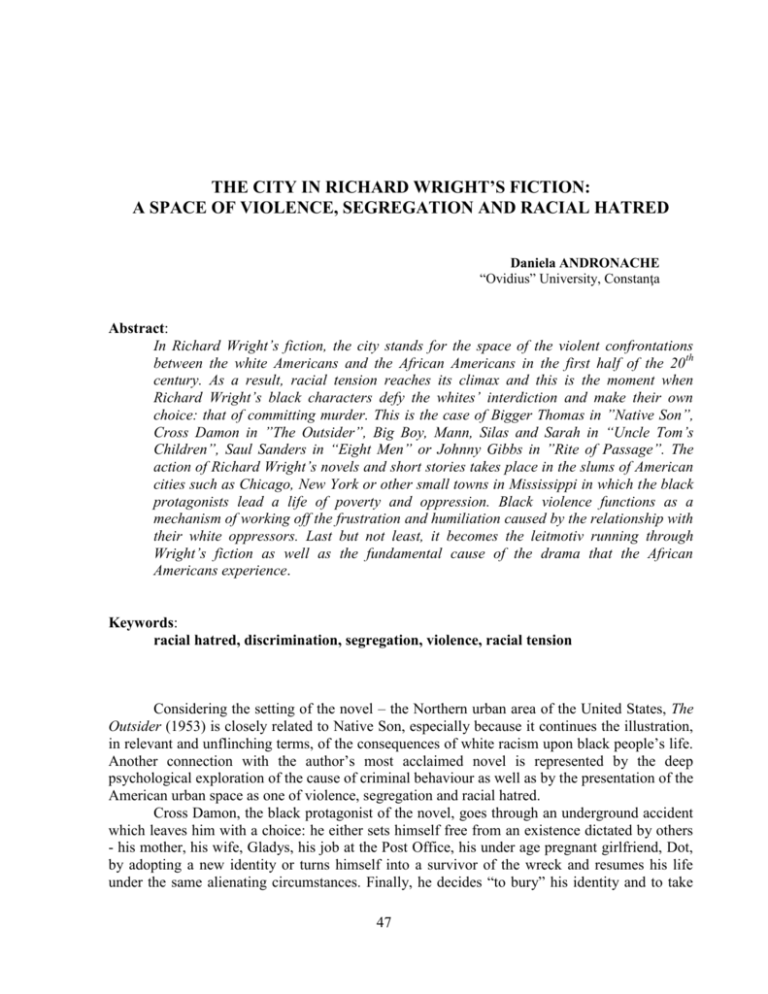
THE CITY IN RICHARD WRIGHT’S FICTION: A SPACE OF VIOLENCE, SEGREGATION AND RACIAL HATRED Daniela ANDRONACHE “Ovidius” University, Constanţa Abstract: In Richard Wright’s fiction, the city stands for the space of the violent confrontations between the white Americans and the African Americans in the first half of the 20 th century. As a result, racial tension reaches its climax and this is the moment when Richard Wright’s black characters defy the whites’ interdiction and make their own choice: that of committing murder. This is the case of Bigger Thomas in ”Native Son”, Cross Damon in ”The Outsider”, Big Boy, Mann, Silas and Sarah in “Uncle Tom’s Children”, Saul Sanders in “Eight Men” or Johnny Gibbs in ”Rite of Passage”. The action of Richard Wright’s novels and short stories takes place in the slums of American cities such as Chicago, New York or other small towns in Mississippi in which the black protagonists lead a life of poverty and oppression. Black violence functions as a mechanism of working off the frustration and humiliation caused by the relationship with their white oppressors. Last but not least, it becomes the leitmotiv running through Wright’s fiction as well as the fundamental cause of the drama that the African Americans experience. Keywords: racial hatred, discrimination, segregation, violence, racial tension Considering the setting of the novel – the Northern urban area of the United States, The Outsider (1953) is closely related to Native Son, especially because it continues the illustration, in relevant and unflinching terms, of the consequences of white racism upon black people’s life. Another connection with the author’s most acclaimed novel is represented by the deep psychological exploration of the cause of criminal behaviour as well as by the presentation of the American urban space as one of violence, segregation and racial hatred. Cross Damon, the black protagonist of the novel, goes through an underground accident which leaves him with a choice: he either sets himself free from an existence dictated by others - his mother, his wife, Gladys, his job at the Post Office, his under age pregnant girlfriend, Dot, by adopting a new identity or turns himself into a survivor of the wreck and resumes his life under the same alienating circumstances. Finally, he decides “to bury” his identity and to take 47 the identity of Lionel Lane, whose name he chooses from a graveyard. It is in this unexpected accident that Cross sees a chance that the destiny offers him in order to avoid the danger of being put in prison for raping a girl under the age of sixteen. This is a crucial moment that implacably changes the trajectory of his life and triggers a series of interrelated events. After he incautiously reveals his new identity to Joe Thomas, he realizes that he must kill him lest he should be denounced for illegally changing his identity. Then, in order to avoid being arrested by the police, he flees to New York where he meets a black West Indian worker who invites him to meet some fellow Communists. He is provided accommodation by Gil Blount, a Party Center Committee member with a view to persuading him to join the Communist Party. But Cross falls in love with Gil’s wife, Eva, a white artist and becomes increasingly critical of the members of the Party since he finds their attitudes racist and condescending. Gil is doing his best in order to recruit Cross but in spite of his attempt, the latter looks down on Gil especially after secretly reading Eva’s diary. Then he discovers that she is not a happy wife and that Gil followed orders to marry Eva so that the Party may benefit from her talents. Cross comes across Gil and Herdon while the two of them are having an argument and kills them both for different reasons: he kills the first one to save Eva from an unhappy marriage and the second one to take revenge on the racist owner of the building in which he was offered accommodation. Jack Hilton, another leading Party member, adds to the list of Cross’ murders. Then he makes a full confession to Eva who is so horrified by his abominable deeds that she commits a suicide. Therefore, death seems to accompany Cross Damon wherever he goes. Just like Bigger Thomas, Cross considers violence as an appropriate method through which he can gain his freedom and escape from white domination. But while Cross kills to defend his new identity and to ensure transformation, Bigger kills for survival. In Black Boy, A Record of Childhood and Youth, the author depicts the climax of white violence against black people. The “black boy” is compelled to learn facts about life in a climate of terror, fear, hunger, hatred and violence that turns his life into a nightmare: ”My sustained expectation of violence had exhausted me. My preoccupation with curbing my impulses, my speech, my movements, my manner, my expressions had increased my anxiety” (Black Boy 197). If one is to deal with the boomerang effect, then this is the case of white people. The violence that they use against blacks, turns against them from time to time: Cross Damon kills four persons and all of them are white whereas Bigger Thomas in Native Son kills both a white and a black girl. Just like all the black characters from Wright’s prose, Bigger is considered an inferior human being and therefore he is not allowed to socially interact with members of white society. This results in a total failure of the process of identity formation, which eventually leads to a split self and implicitly, to an identity crisis. Quite significantly, the identity crises spans almost a life time, since he never actually succeeds to rehabilitate himself in front of white society. The fear and hatred that constitute leitmotivs running through all Wright’s fiction, replace rationality and equilibrium and turn him into a semi-wild creature capable of irrational acts. To put it in a nutshell, because of white racism, the simple gesture of helping a white girl climb up the stairs becomes a moral dilemma for a black man. Henceforth, he accidentally kills Mary Dalton, the daughter of his employer, for fear he might not be discovered in her bedroom after he helped her climb the stairs while this one was in an advance state of inebriation. Shortly after, Bigger kills his black girlfriend, Bessie Mears for fear that she might inform on him. If Bigger had been caught in a white girl’s bedroom, this would have meant only one thing – rape. It is thought that, according to the rules of American society, a white woman would never voluntarily have a sexual intercourse with a black man. It may well be argued therefore 48 that the primary cause of Bigger’s terrifying experience is white racism which led in his case to violence and murder. Moreover, a single but extremely relevant scene from Richard Wright’s work contains the essence of white racism in 20th century American society.In connection with the idea that Wright is the first African American author that depicts violence in a black man, Bernard Bell, in his volume The African American Novel and its Tradition reiterates this idea while dealing with ”the myth of the Bad Nigger”: In the course of the novel, Bigger is controlled by social and psychological forces that drive him to self-hatred, a rejection of his family and race, a knife attack on his closest friend, the murder and mutilation of his employer's daughter, and the rape and murder of his girlfriend. With stunning power, Wright's naturalistic vision affirms the myth of the Bad Nigger and attempts to develop it into a kind of modern Everyman (Bell 156-157). The social and psychological forces that Bernard Bell identifies in Native Son are also incriminated by Richard Wright who deeply thinks that, if whites had treated Bigger as a human being, he would not have become a killer. The most dramatic part of the story is represented by Bigger’s strong belief that he can ensure his own survival only by killing Mary Dalton and Bessie Mears. Bigger is aware of the fact that his presence in Mary Dalton’s room is undoubtedly synonymous with the infringement of an important law of a Jim Crow society. Consequently, when Mrs. Dalton enters Mary’s room, Bigger completely loses control of himself as fear overwhelms him. When Mrs. Dalton approaches the bed, fear reaches the climax and, as a result of it, he is so frightened that he intuitively acts to escape punishment and to save his life. Bigger’s reactions are so vividly described that a careful reading of the scene convinces the reader that Bigger does not act with “evil intent” (Bloom 76). In this respect, it is likely that the reader may empathize with him because of the intense fear that motivates his actions: “Bigger wanted to take enough air into his lungs to scream: «Yes, I was scared! » But who would believe him?”(Native Son 365). Thus, characteristic of tragedy, Bigger’s loss of control caused by fear plays the paradoxical role of making him at once a vulnerable human being who deserves our compassion and not our contempt. In his book, Richard Wright’s Native Son, Andrew Warnes agrees with an obvious social fact generated by white society and white mentality - blacks are segregated from whites in every area of life: Today, to be sure, we know that the Negro is not biologically or mentally inferior; there is no truth in those rumours of his body odours or his incorrigible sexuality; (…). Yet, in our most recent war, his blood was segregated as was, for the most part, his person. Up to today we are set at a division, so that he may not marry our daughters or our sisters, nor may he – for the most part – eat at our tables or live in our houses (Warnes 78). In connection with the same idea of blacks’ segregation and, implicitly, of the American city as a space of segregation and racial discrimination, Robert Felgar wrote about the strong impression and huge influence that Wright’s novel had upon him in his Student Companion to Richard Wright: “In Bigger Thomas, Wright created a nightmarish warning of what is being produced in the urban ghettoes. He never again wrote such a powerful book” (Felgar 7). In the South, where Richard Wright was born on a plantation in Natchez, Mississippi, in 1908, their situation worsened, mainly because of the Southern government that ratified laws 49 meant to deprive them of civil rights and to keep them in a low social condition. In addition to it, “there was also a powerful organization called the Ku Klux Klan which used violence against blacks” (High 211). Because of this, numerous blacks began moving from the South to the Northern cities where their situation was somewhat better. The author himself moved to New York in 1927 to pursue his career as a writer. In 1947 he expatriated himself to Paris in response to the racial hostility he and his family encountered in New York. In Paris he continued to live with his family and to write until his death in 1960. With Native Son, Richard Wright makes an outstandingly courageous attempt to break the silence that surrounded racism in America to the benefit of white people. Since Native Son is his most highly praised as well as his best known novel, it seems that the author fulfilled his objective to struggle against racism by his own artistic means. A memorable illustration of white racism and violence is offered by Richard Wright in Uncle Tom’s Children. Being the black protagonist of the story, the author was also the victim of white violence. One day while he was delivering packages in the suburbs, his bicycle got punctured and he was invited by a white man who was driving past him to cling to the side of his car. The white individual was accompanied by a group of other white men who were drinking whisky. The author refused the invitation, but he was not very polite since he omitted to pronounce the word “sir”. This lack of politeness resulted in his mercilessly being hit in the face with an empty whisky bottle: The words were hardly out of my mouth before I felt something hard and cold smash between the eyes. It was an empty whisky bottle. I saw stars and fell backwards from the speeding car into the dust of the road, my feet becoming entangled in the steel spokes of my bicycle. The white men piled out and stood over me. “Nigger, ain’ yuh learned no better sense’n tha’ yet?” asked the man who hit me. ”Ain’ yuh learned t’ say sir t’ a white man yet?” (Uncle Tom’s Children 9). On the other hand, the simple act of saying “thank you” to a white man can be, in certain circumstances, a troublesome one. The context of the race relations in the 20th century American society is so problematic, that its intricacies give birth to a rather complex situation that makes the black individual think deeply of what he has to say or do in order to avoid being the victim of white violence. In other words, this kind of experience leads to the creation of some social representations in his mind that help him to have a correct evaluation of whites’ violent potential. It also teaches him many things about the way in which he should interact with them in the future so as to avoid being the victim of white violence in the American urban space: “I was learning rapidly how to watch white people, to observe their every move, every fleeting expression, how to interpret what was said and what left unsaid” (Black Boy 183). However, we should point out that all Richard Wright’s black characters are forced to adopt a humble and subservient attitude in order to avoid the aggressive manifestations of white racism. Pursuant to Yoshinobu Hakutani, this fact results in a lack of racial pride for which Richard Wright was blamed both by black as well as by white critics. Yoshinobu Hakutani ascribes this typically black phenomenon to the oppressive social forces of American society: 50 Needless to say, the forces of racism have devastating effects on black life. Critics, both black and white, have complained that Wright in Black Boy lacks racial pride. It is true that he is critical of the black community in the South, but it is not true that he places the blame on the black community itself. His intention is to show that a racist system produced the way of life that was forced on black people. In terms of social determinism, Black Boy provides a literary experiment to demonstrate uniformity in Negro behaviour under the influence of social forces (Andrews, Taylor 137). Although the black protagonists of Wright’s novels and short stories are not aware of the accepted social norms of white racist society from the beginning, they come to learn them either as a result of their personal racial experience or because they are instructed in this respect by the elder members of their family or their ethnic community. In The Ethics of Living Jim Crow the little “black boy” is scolded and warned by his mother about the risk of being killed by whites if he keeps on fighting against them. Much later, when he becomes a teenager and works in an optical company he has a racial conflict with two white employees who exert their verbal aggression upon him because they want him to leave his job. When his white employer is told about the conflict and asks “the black boy” to inform on his aggressor, this one firmly refuses because he meanwhile has found out from other black character’s experience that the consequences can be very bad for him: “I looked at the white faces of Pease and Reynolds; I imagined their waylaying me, killing me. I was remembering what had happened to Ned’s brother”(Black Boy 194). In Big Boy Leaves Home, black violence triggers a wave of violent acts from the part of white people as well. The main black character, Big Boy, kills a white man and he manages to escape North with the help of black community. In Down by the Riverside, the author presents the drama of a black individual called Mann who, against his wish, shoots a white person because this one wants to confiscate the boat he urgently needs to take his pregnant wife to the hospital. When he finally arrives at the hospital, his wife is already dead. After a violent confrontation, Mann is arrested and killed by the white soldiers. In a way, Big Boy resembles Bigger Thomas in the sense that, just like Big Boy, the protagonist of Native Son commits his murders almost automatically and under the great pressure of the moment. Long Black Song illustrates another case of black drama: Sarah is raped by a white man and her husband, Silas wants to retaliate by shooting whites, but he is finally killed by them. In Fire and Cloud, the reverend Dan Taylor fights for blacks’ civil rights while trying to organize some protest demonstrations. This is something that whites do not tolerate, especially the mayor of the town who asks the reverend to use his influence so as to convince his fellow beings “to stay off the streets” (Uncle Tom’s Children 185). He refuses to comply with the mayor’s request and, as a result of it, he is arrested and severely whipped by the police. Quite obviously, dissemblance is replaced by the direct and violent confrontation with their white opponents. This time Wright’s characters – Mann, Silas and Dan Taylor manifest a militant resistance and they no longer think that subservience and obedience can be of any help to them. On the contrary, Dan Taylor is animated by the firm belief that “theys gonna treat us this way as long as we let them.” (Ibidem 209) and he is determined to continue his struggle by all means. 51 White cruelty and violence seem to culminate in Bright and Morning Star. It is Sue’s story, the mother of Sug and Johnny Boy. The latter organizes a secret reunion of the local Communists. The police discover the plot, arrest Johnny Boy and try to make this one inform on the rest of the plotters under torture. The psychological tension reaches its climax when Sue, with an incredibly desperate gesture, shoots his son in order to put an end to his torture. Richard Wright is the first writer who describes violence in a black man (High 215). Therefore, we insist upon the fact that no trace of uncle Tom’s mildness, piety and subservience can be detected in his “children”. The unbelievable example of human endurance embodied by Stowe’s character seems to be old fashioned for Richard Wright who prefers to construct his characters from a belligerent, activist perspective, thus suggesting his profound disbelief in the efficacy of the Christian principle of “turning the other cheek”. The Man Who Lived Underground, a short story that Wright wrote in 1945 and that was included in Eight Men, represents an illustration of the way in which blacks are “invisible” in American society (Ibidem). In fact, the author created a new and interesting metaphor that is later used by Ralph Ellison in his novel Invisible Man. The black protagonist is running away from some “policemen who had wrongly accused him”(Eight Men 27). As the situation stands, the underground seems to be the safest place for him to hide. Quite obviously, the obstruction of the identity formation process is suggested from its very title. Living underground renders him invisible for white society. His existence, although objective and undeniable, does not have any social consequences or implications. If in the previously analysed volume - Uncle Tom’s Children, white people used extreme violence as an immaterial element to eliminate the rebellious blacks from the social scene, in this short story the underground stands for the concrete element that obstructs the natural development of the black protagonist’s ego identity. Mention should be made that there are some interesting facts regarding this location. The most interesting one is that, on the one hand, living underground does not definitely eliminate the black protagonist from the social scene, but it only deactivates him for the time being. On the other hand, although it is a safe place to live, it reduces all the three dimensions of his self – “the psychological”, “the personal” and “the social” one. Henceforth, we can say that his identity is no longer socially, culturally and historically constructed, but “underground” constructed: He had to live this foul place, but leaving meant facing those policemen who had wrongly accused him. No, he could not go back aboveground. He remembered the beating they had given him and how he signed his name to a confession, a confession which he had not even read. He had been too tired when they had shouted at him, demanding that he sign his name; he had signed it to end his pain (Ibidem). The Man Who Killed a Shadow reiterates the typical themes of Wright’s prose – fear, hate and segregation - that dominate the life of the black protagonist, Saul Sanders, who realizes that “he came into a world that was split in two, a white world and a black one, the white one being separated from the black by a million psychological miles” (Ibidem 185). Quite predictably, the climate of racial hostility is not a favourable one for the spiritual and intellectual development of the black boy: “It is quite normal in his environment to reach the age of fourteen and still be in the third grade” (Ibidem 187). The delay in the intellectual development of the black protagonist as well as in his identity formation process is due to the existence of a white racist mentality based on the 52 principle of racial inferiority: “He quickly learned that the strange white people for whom he worked considered him inferior; he did not feel inferior and he did not think he was” (Ibidem). Just like in the case of other black characters in Wright’s work, extreme violence functions as a way of working off his continually accumulated fear, fury and frustration: “Then he took a deep breath and surrendered to the world of shadows about him, the world he had feared so long; and at once the tension went from him and he felt better than he had felt in a long time” (Ibidem 200). It may well be argued that committing a murder represents in Saul’s view a modality through which he re-establishes the “social dimension” that the racist society has annulled in him. Paradoxical as it may seem, by committing a murder, the black protagonist draws whites’ attention upon their humanity – it is their unconscious way of saying that they do not stand for objects, but for human beings. Therefore, they can do a lot of things, they can even commit murders. In Rite of Passage, published more than thirty years after the author’s death, Richard Wright illustrates the most dramatic case of identity crisis. This time the protagonist of the novel is a fifteen year old black boy, Johnny Gibbs who, without knowing it, is brought up by a foster family. Unaware of his origin, he prospers in almost every way, but at the age of fifteen the authorities order that the boy should be transferred to a new foster family. In his own way, Wright blames American authorities for the insensitivity and the absurdity of the decisions that they make with respect to the African American children and families. Removing a child from a family in which he led a happy life for fifteen years represents in fact an example of an absurd decision and it triggers a wave of vain protests not only on Johnny’s part but also on his foster family. The climax of the whole story is represented by the moment in which Johnny is given the great piece of news by his foster mother. It is an extremely intense moment from the emotional point of view and, at the same time, it becomes a turning point in Johnny’s life. From that moment on, the black boy does away with his happy childhood for ever. It is also the moment when the symbolical title of the novel – Rite of Passage- gains the full relevance of its meaning. In other words, this is the moment that tragically depicts the protagonist’s passage from a world of normality to the bleak and doomed realm of delinquency: He understood it all now and his eyes were two frozen pools of black stone. He had heard and he had not heard; the words had been too charged for him to sense all that they mean. Only a half an hour ago his world has been so solid, real; now he lived in a hot, sick dream. The mother he loved so deeply was now disavowing him, cutting him off, telling him that all his life had been a lie. (Rite of Passage 16-17) The totally unexpected news has such a powerful impact upon Johnny Gibbs that it almost petrifies him and it makes him experience an existential shock meant to definitely mark his life and to split his self. The absurd decision of the authorities puts an end to his idyllic life and gives free way to antisocial acts. Leaving his childhood behind forever, he continues his existence on the streets of Harlem where he meets a gang whose members also used to live in foster homes. Based on common experience and shared values, Johnny’s relationship with them appears to him as a promise of a new and tumultuous life. Finally, they persuade him to take part in mugging a white man: “Yes, this was his passport to his new life, to the new and 53 strange gang of boys upon whom he would have to depend for his food, for friendship” (Ibidem 57). His living on the streets represents in fact a brutal interruption of his identity formation process and it is also a moment of great spiritual loss. On the one hand, the psychological implications of his removing from his foster family are so deceptively negative that they automatically cancel the deep sense that the black boy had about his continuity in time. On the other hand, his split self does not allow him to integrate himself into another foster family and, implicitly into society: “well, if he could not have them as his family, then he wanted no family” (Ibidem 28). His firm decision of running off – “if you make me leave, I’ll run off!”(Ibidem 18) – has its roots in the great disillusionment caused by his mother’s announcement that he was to leave his home forever. The black boy perceives this speech act as a painful betrayal and, at the same time, he realizes that he constructed his identity on an illusion. This radical change shatters his life into pieces and it makes him aware of the real identity of his foster parents- they have proved to be some strangers who betrayed him and banished him from their house. The outcome of all these is the fact that he turns himself into a character with no consistency that loses the control over his life. It becomes clear that black people’s life is deeply affected by white racism in that it destroys their identity and personality and it represents a blatant violation of their individual freedom and dignity as well as a virulent negation of their human worth. But at the same time, white racism gives birth to an unexpected paradox: although from the political and economic point of view, whites’ position is superior to that of blacks, a fact that actually justifies their racism, from the moral point of view, their position is inferior and this is a universally valid fact: irrespective of the society and the epoch in which they live, oppressors, although rich and powerful, are morally guilty for the suffering that their violence and oppression inflicted on the oppressed. Furthermore, it may well be argued that racism affects not only blacks’ life as we have demonstrated so far, but also whites’ life. More concretely, a moral imperative of a multiethnic and multicultural society consists in the establishing of a climate of peace and social harmony. It is quite obvious that, in the context of the twentieth century American society that Richard Wright depicts in his work, this thing stands for an utopia, mainly because racism cancels white American’s quality of being kind, generous and friendly and transforms him into a hostile and cruel individual. To draw a conclusion, it must be admitted that almost each and every black character in Wright’s fiction uses extreme violence against whites gaining the identity of a murderer in the course of the novel or of the short story whereas the urban space in Wright’s fiction is undoubtedly one of violence, segregation and racial hatred. 54 References Andrews, William L., Taylor, Douglas. Richard Wright’s Black Boy (American Hunger). New York: Oxford University Press, 2003. Bell, Bernard W. The African American Novel and Its Tradition. Amherst MA: University of Massachusetts Press, 1989. Bloom, Harold. Richard Wright’s Native Son. New York: Chelsea House Publishers, 1988. Felgar, Robert. A Student Companion to Richard Wright. Westport CT: Greenwood Press, 2000. High, Peter B, An Outline of American Literature. New York: Longman, 1999. Warnes, Andrew. Richard Wright’s Native Son. London and New York: Routledge, 2007. Wright, Richard. Uncle Tom’s Children. New York: Harper Collins Publishers. 2008 (first ed.: 1940). Wright, Richard. Rite of Passage. New York: Harper Trophy, 1994 (first ed.: 1994). Wright, Richard. Native Son. London: Vintage Books, 2000 (first ed.: 1940). Wright, Richard. Black Boy (American Hunger). London: Vintage Books, 2000 (first ed.: 1945) Wright, Richard. Uncle Tom’s Children. New York: Harper Collins Publishers, 2008 (first ed.: 1940) Wright, Richard. Eight Men. New York: Harper Collins Publishers, 2008 (first ed.: 1940) 55


